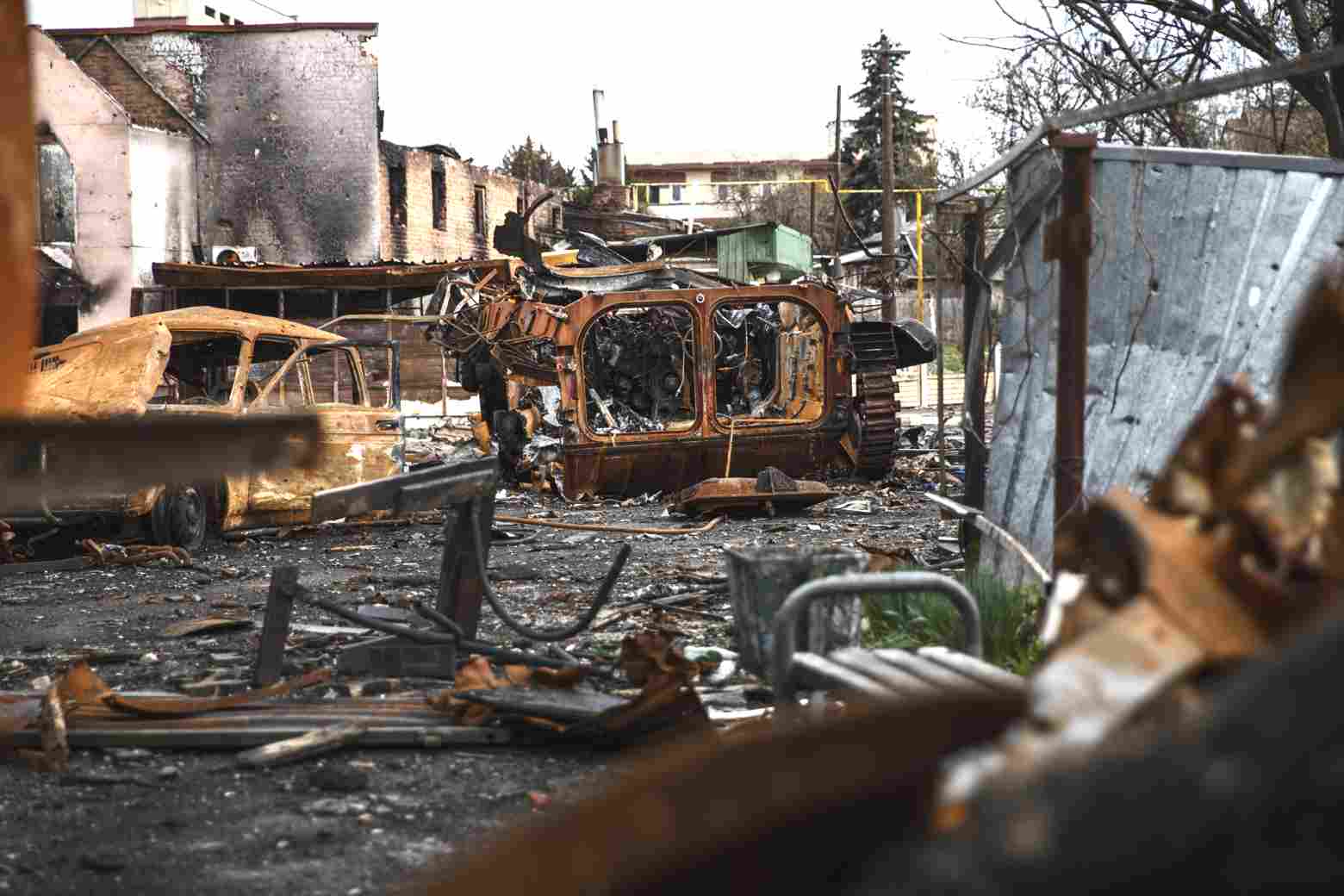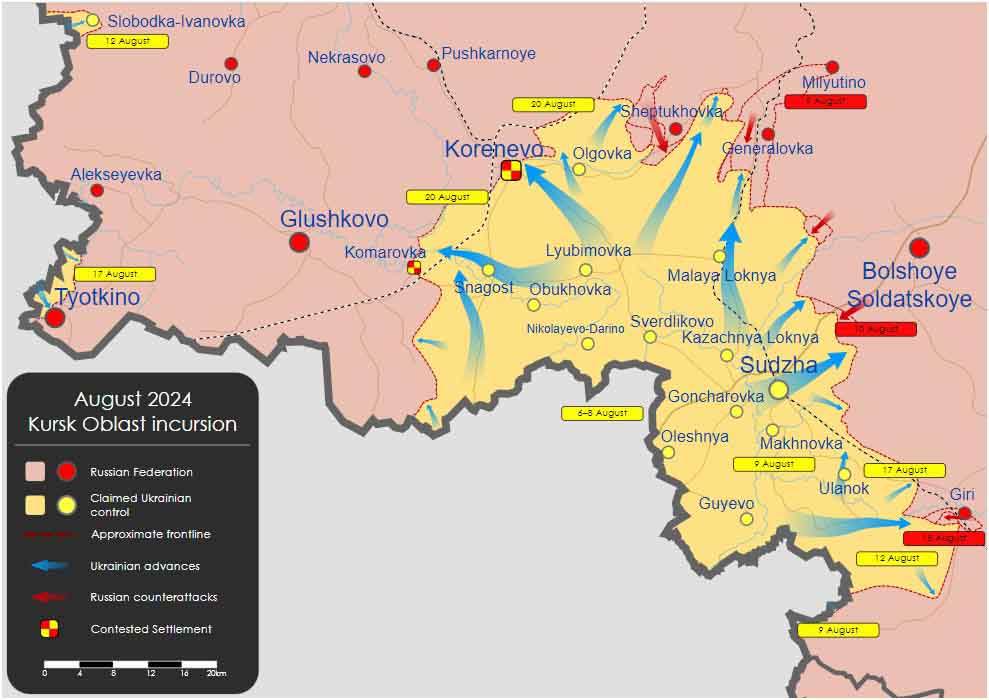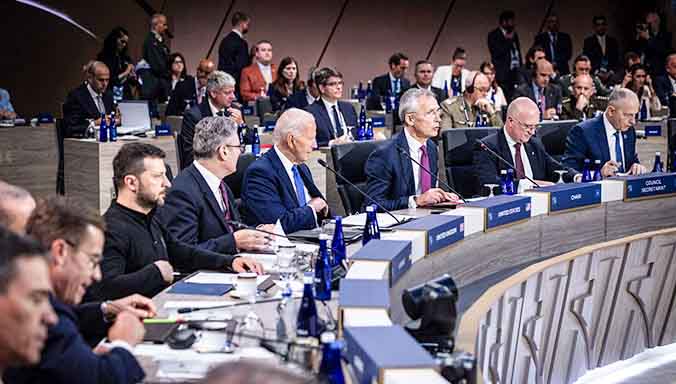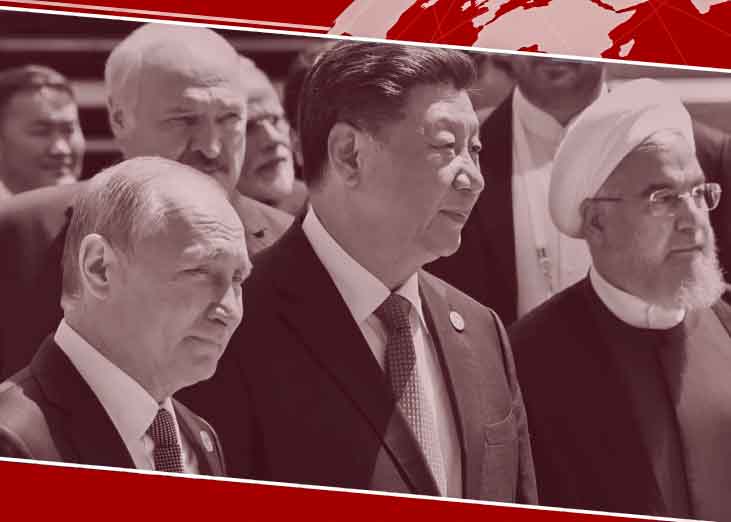This is a continuation of the article on the Ukrainian offensive in Kursk Oblast. We will now look at the details of this operation: its tactical and operational aspects, and its effects. We remind you, however, that the Kursk operation is still ongoing, so any details about it must necessarily be uncertain, and any analyses preliminary.
What Will Putin Do?
Ukrainian commanders were surprised. They had expected a stronger and much more stubborn resistance to their — indeed unexpected, even for Ukraine's allies — invasion of Kursk Oblast. Despite claims by Kremlin-controlled media about effective resistance and victory over the "aggressor," so far — and it has been a month now — there has been no sign of any results. Again, the question dominates: what will be Putin's final response?
The malicious seek an explanation in the fact that Putin may once again be demonstrating how he becomes paralyzed in a crisis and disappears from public view. This is a trait, let us add, that was previously noted in Joseph Stalin, who, in the face of German aggression in 1941, withdrew to his dacha and remained in seclusion.
Putin’s strategy so far has been to portray these events as a natural disaster and focus on humanitarian aid—of course, against the backdrop of the full spectrum of Russian incompetence and corruption that characterizes the current regime. The Kremlin dictator has remained remarkably tight-lipped about the invasion of Russia, limiting himself to just a few public statements. He recently declared that Ukraine had miscalculated because the Russians had failed to withdraw significant forces from the Donbas and were continuing to conduct an offensive there.
Ukrainian leaders, for their part, are now waiting for some kind of concrete response from Russia—and wondering why it has taken so long. They, too, have dilemmas to grapple with. Should they stay and dig in to defend the advanced foothold they have created inside Russia? Should they withdraw completely? Or just partially and create a buffer zone?
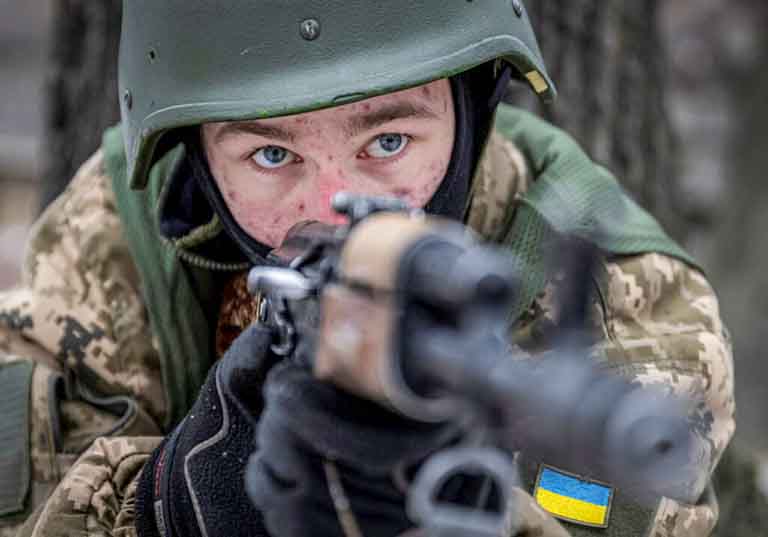
(Source: Ministry of National Defense of Ukraine)
Initial success in the offensive does not necessarily have to translate into lasting territorial gains. For the latter to happen, massive logistical operations are needed: building fortifications, tightening supply lines, bringing additional reserves into the fight. Only time will tell whether Ukraine will cope with these tasks. For now, according to observers, there is no visible effort to build fortifications on the Ukrainian side, but such efforts are clearly visible on the Russian side.
What has been achieved so far?
According to the latest reports from late August and early September 2024, we can observe that:
The attack on Kursk allowed Ukraine to set a precedent for further offensive operations. It undoubtedly gave new life to the weakened Ukrainian forces. Since the offensive began, they have advanced as much as 35 kilometers (22 miles) into Russian territory.
Ukraine has managed to occupy more than 1,000 square kilometers (about 390 square miles) of Russian territory during its offensive in Kursk Oblast. In addition, Ukrainian forces have captured up to 100 settlements in the region. This marks the largest invasion of Russian territory since the beginning of the war in 2022, and by extension, the first land invasion of Russian territory itself by a foreign power since the end of World War II.
The Ukrainian offensive has also dealt a blow to Russian President Vladimir Putin's reputation as an invincible defender of mother Russia's borders. There are hopes that it could eventually raise doubts about the point of the war among Russians, and even spark social unrest — but only if information about it reaches public opinion inside Russia at all.
The attack in Kursk region created the conditions for the return of a larger number of Ukrainian prisoners of war on an exchange basis. This was made possible by the capture of many Russian combatants – the largest number of prisoners of war in a single operation to date. Hundreds of soldiers are said to have been taken prisoner, most of them new conscripts.
Ukraine's sudden incursion into Kursk and Russia's initial lack of a decisive response exposed Moscow's weaknesses, reminding us that even Russia's vast resources are not limitless, nor are its forces invincible.
Ukrainian forces have proven their ability to surprise the enemy, regaining the initiative on the battlefield after a series of setbacks in eastern and southern Ukraine since last year.
Ukraine has proven that it is capable of conducting effective offensive tactical operations, even against superior Russian forces.
Some advantage has been gained in potential peace negotiations with Moscow. The captured Russian territory could serve as a bargaining chip for Ukraine, which has recently struggled to secure significant battlefield victories. However, with the operation still ongoing, it is unclear how much Ukraine has gained from it. Ukraine may seek to exchange land captured in Kursk Oblast for territory, for example, in Kharkiv Oblast, that Russia captured during its recent offensive, since the areas are “somewhat comparable.”
Ukraine has also established a military administration in these areas. This can be an instrument for building trust among the residents of these areas in the Ukrainian authorities. The military administration can also facilitate the distribution of humanitarian aid and the initiation of reconstruction processes that may have been difficult or impossible under Russian control.
Recently, Russian soldiers have reportedly been observed, as is their custom, looting on a large scale in territories still under Russian control, taking advantage of the momentary confusion. This is evidence of a lack of discipline in the army and problems with morale. This state of affairs can worsen the effectiveness of military operations, because a demoralized army does not function effectively on the battlefield. The consequences could be a challenge to the authority of the government and social discontent, which could affect the political calculations of the Kremlin.
Ukraine's Tactical Advantages
During the Ukrainian offensive in Kursk Oblast in August 2024, Ukraine used several significant tactical advantages, which were confirmed by reliable sources:
Strategic Surprise: Ukrainian forces surprised the Russians with their attack on Kursk, allowing them to quickly seize large swaths of territory. The Russian defenses were unprepared for such a move, allowing Ukraine to make rapid advances.
Precision Strike Capability: The Ukrainian military has effectively used precision strikes against key infrastructure targets, such as bridges and supply lines in the Kursk region. These strikes have made it more difficult for Russia to move additional forces and support into the fighting, which in turn has helped to cut off some Russian forces.
Mobility and flexibility: Thanks to the delivery of modern equipment, including armored vehicles and artillery systems of Western production, Ukraine has gained mobility, which allows for rapid movement and flexibility in offensive operations. Ukraine will significantly increase the mobility of its units, which allowed for rapid movement and adaptation to the changing situation on the battlefield. This allowed Ukrainian forces to effectively maneuver and avoid heavy losses in clashes with the Russian armed forces. This clearly showed its effects in the Kursk region.
Use of technology: Ukraine, thanks to Western support, has gained access to modern reconnaissance and electronic warfare systems, which allows for better planning and implementation of operations, including attacks on key logistical targets.
Use of irregular warfare: Ukrainian forces continued to use irregular tactics, such as drone strikes on Russian positions and guerrilla warfare to disrupt Russian lines of communication. These actions disorganized Russian defenses and hindered coordinated counterattacks.
Ukraine was able to use the element of surprise well. It is obvious that the Russians did not expect the attack. This calls into question their intelligence capabilities, and also allows us to highly evaluate the Ukrainian ability to conduct an appropriate concentration of troops and equipment at the border so efficiently that they managed to surprise the enemy. This is very difficult in today's battlefield conditions.
Tactical challenges
An offensive of this scale always involves risk, and for Ukraine in the current situation, this risk is enormous. Conducting operations in enemy territory involves serious tactical challenges:
Logistical Difficulties: Operating in enemy territory always poses logistical challenges. Ukraine would have to ensure that its troops in Russia are supplied, which could be difficult given its distance from its bases and the risk of Russian retaliation.
Counter-attack possibilities: Russia, with its generally superior military forces, could launch a counter-attack against Ukrainian forces, which could negate Ukraine's territorial gains and lead to further losses. So far, this has not happened, but Russia, aware of the threat, has stepped up its defense of the region. This means that Ukraine must expect greater difficulty in breaking through Russian defense lines.
Strengthened Russian defenses: Russia has invested in developing defense and logistical infrastructure in the Kursk region, which could make it more difficult for Ukraine to achieve its operational goals.
Planning and Execution of Offensive: Conducting an offensive into enemy territory requires complex operational planning. Ukraine would have to plan precisely how its forces would react, taking into account the possibility of a Russian response and potential logistical difficulties. As part of its operational planning, it would also have to anticipate various scenarios, including the possibility of Russian counterattacks and the need to evacuate its forces if unsuccessful. It is not clear how far ahead their operational plans go.
International Support: To carry out such an operation, Ukraine must count on the support of its international allies, especially in terms of weapons supplies, intelligence information, and logistical support. However, this support could be limited if the offensive is deemed too risky or the conflict escalates.
Political and propaganda response: Russian propaganda is using Ukraine's offensive to further stoke nationalist sentiments in the country. The Kremlin presents the attack as evidence of Ukraine's aggressive policy, which in turn is supposed to justify further military action and social mobilization.
Insufficient relief in other areas: Russia simultaneously continues offensive operations in other regions, such as Donbas, thereby preventing Ukraine from achieving one of its — if not the most important — strategic goals.
Duration of the operation: As the conflict drags on, Ukraine will face increasing difficulties in maintaining the offensive, especially in terms of supply and the rotation of forces on the front.
Limited propaganda reach: The Kremlin continues to use media it controls to build a narrative in which Ukraine and its Western allies are the main culprits in the escalation of the conflict. A large part of the Russian population is completely unaware of what is happening and the scope of the conflict.
Losses in personnel and equipment: Ukraine has committed many of its reserves to the fight in Kursk Oblast—some say all of them. Losing these assets would be a real disaster.
Strategic Risks
The invasion of Kursk Oblast could have been a masterpiece of Ukrainian strategy, provided it had been carefully prepared and planned for the long term. However, since the initial success of the operation surprised both the Russian defenders and the Ukrainian initiators, one cannot help but feel that the entire operation was poorly prepared and had no long-term goals.
While Ukraine has made some tactical gains, there are concerns about the offensive’s long-term effectiveness, especially as Russian forces remain fortified and continue to operate on other fronts. Critics say the operation may have drawn Ukrainian forces away from critical areas such as eastern Ukraine, where Russian forces have not reduced the intensity of their attacks.
Ukraine's offensive in Kursk Oblast, in the context of current developments on the front, remains a risky but potentially still beneficial operation. Its final outcome, however, depends on many factors, including Ukraine's ability to continue it effectively, Russia's reaction, and the international support that Kyiv may or may not receive during and after the offensive.
Failure of the Kursk operation could lead to escalation of the conflict, huge losses in people and equipment, and a dramatic deterioration of the situation on other fronts. This is a big stake and the Ukrainian leadership has put a lot on one scale. We will see if it was worth it.









